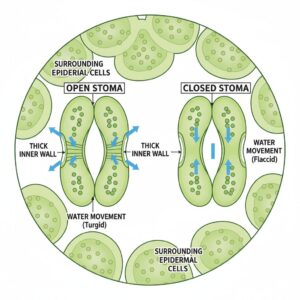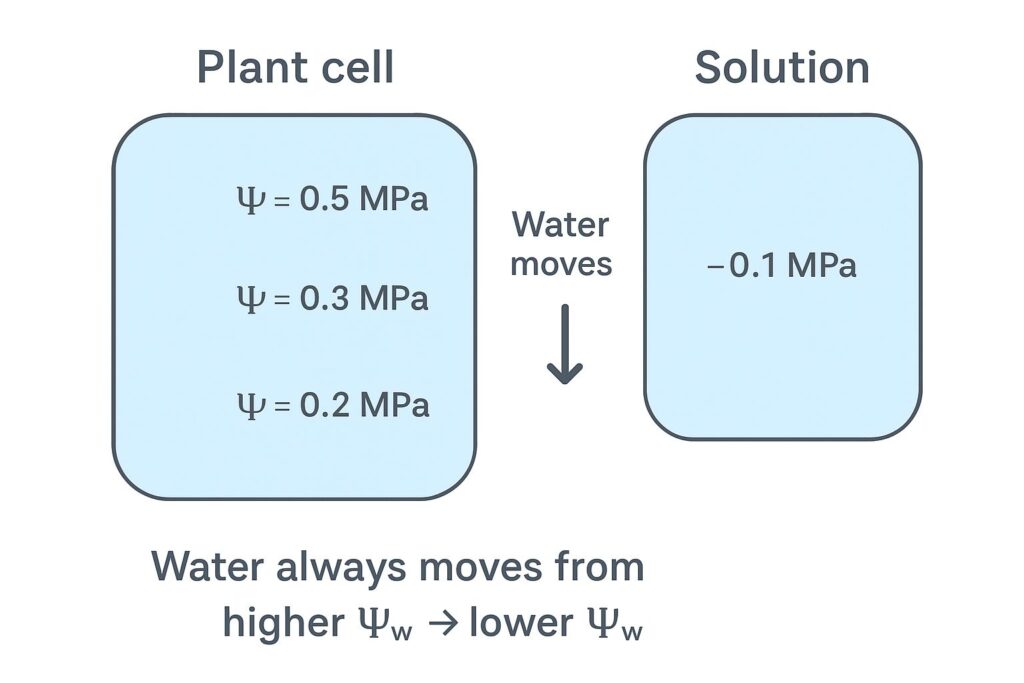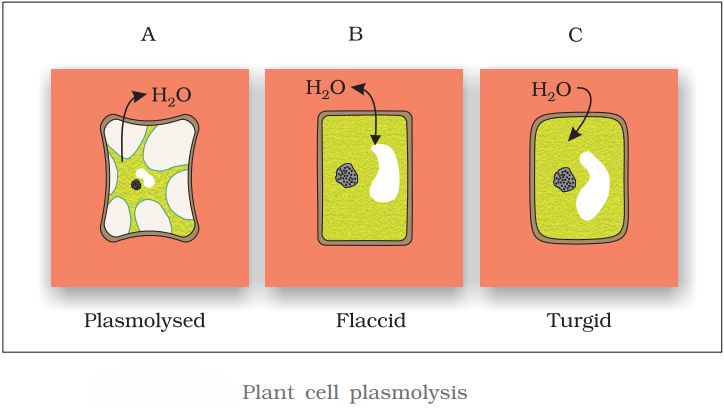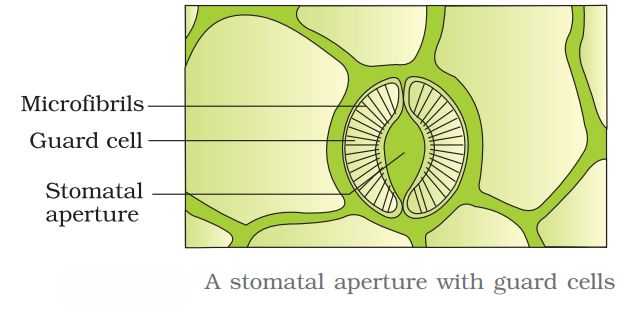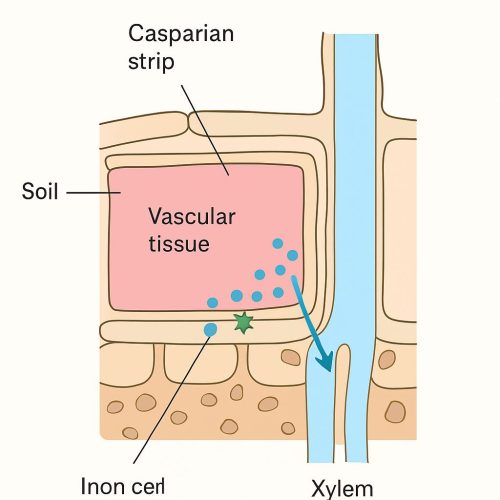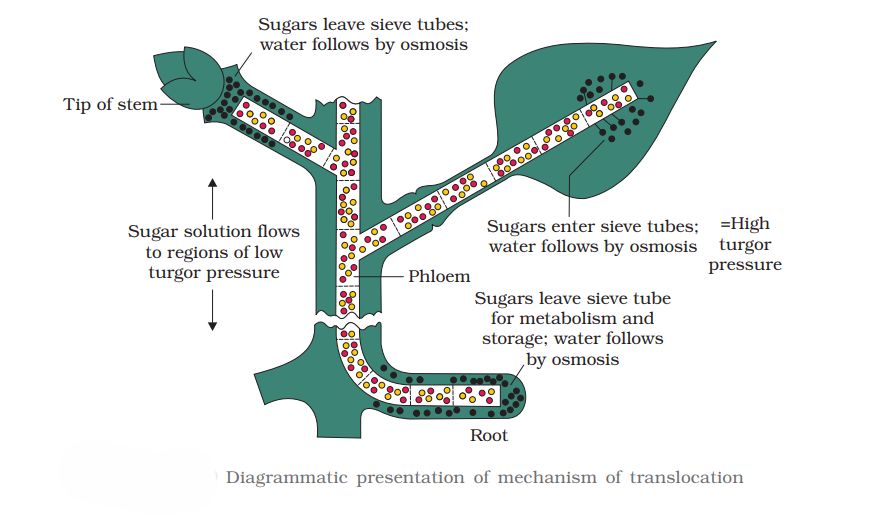1st PUC Biology Question and Answer: Transport in Plants
Looking for 1st PUC Biology textbook answers? You can download Chapter 11: Transport in Plants Questions and Answers PDF, Notes, and Summary here. 1st PUC Biology solutions follow the Karnataka State Board Syllabus, making it easier for students to revise and score higher in exams.
Karnataka 1st PUC Biology Textbook Answers—Reflections Chapter 11
Transport in Plants Questions and Answers, Notes, and Summary
1st PUC Biology Chapter 11
Transport in Plants
Scroll Down to Download Transport in Plants PDF
Question and Answer:
Question 1.
What are the factors affecting the rate of diffusion?
Answer:
The factors affecting the rate of diffusion are:
- Gradient of concentration – Greater the difference in concentration, faster is the rate of diffusion.
- Permeability of membrane – The more permeable the membrane, the faster the diffusion.
- Temperature – An increase in temperature increases the rate of diffusion.
- Pressure – Higher pressure can increase the rate of diffusion.
Question 2.
What are porins? What role do they play in diffusion?
Answer:
Porins are proteins that form large pores in the outer membranes of plastids, mitochondria, and some bacteria, allowing molecules up to the size of small proteins to pass through.
Thus, porins facilitate diffusion of substances across the membrane.
Question 3.
Describe the role played by protein pumps during active transport in plants.
Answer:
In active transport, the movable carrier proteins are called pumps.
They perform transport across the membrane against the concentration gradient by using ATP as a source of energy.
Question 4.
Explain why pure water has the maximum water potential.
Answer:
The water potential of pure water at normal temperature and pressure is zero.
When solute particles are added, the free energy of water molecules decreases due to their interaction with solute particles.
Hence, the water potential of a solution is always negative or less than zero.
Therefore, pure water has the maximum water potential.
Question 5.
Differentiate between the following:
- Diffusion and Osmosis
- Transpiration and Evaporation
- Osmotic Pressure and Osmotic Potential
- Imbibition and Diffusion
- Apoplast and Symplast pathways of movement of water in plants.
- Guttation and Transpiration.
Answer:
(1) Diffusion vs Osmosis
Diffusion:
- Movement of molecules (solids, liquids, gases) from higher to lower concentration.
- Responsible for gaseous exchange through stomata and water vapor loss from aerial parts.
Osmosis:
- Diffusion of water (or other liquid) through a semipermeable membrane from higher to lower water potential.
- Water enters root hairs by osmosis; occurs cell-to-cell in plants.
- Two types of osmosis: cell-to-cell water movement throughout the plant body.
(2) Transpiration vs Evaporation
Transpiration:
- Water loss from living aerial parts in vapor form.
- Involves living tissues; a physical and physiological process.
- Controlled by environmental factors (humidity, temperature, soil water) and internal factors (stomata, cuticle).
Evaporation:
- Water loss from free water surfaces.
- Does not involve living tissues; purely physical.
- Controlled only by environmental factors; continues as long as water is present.
(3) Osmotic Pressure vs Osmotic Potential
Osmotic Pressure:
- Hydrostatic pressure required to stop water movement through a semipermeable membrane.
Osmotic Potential:
- Reduction of water potential due to solute; represented by negative values.
(4) Imbibition vs Diffusion
Imbibition:
- Special diffusion: water absorbed by solids (colloids), causing swelling (e.g., seeds, dry wood).
- Water moves along a concentration gradient.
Diffusion:
- Random movement of molecules from higher to lower concentration.
- Slower; occurs in gases, liquids, and solids; independent of living systems.
- Important for gaseous movement in plants.
(5) Apoplast vs Symplast Pathways
Apoplast:
- Water moves through cell walls and intercellular spaces; does not cross membranes until the endodermis.
- Depends on gradient; allows mass flow.
- Tension develops as water evaporates into intercellular spaces.
Symplast:
- Water moves through cytoplasm connected by plasmodesmata; crosses membranes at each cell.
- Movement aided by cytoplasmic streaming; essential for entry into vascular cylinder.
(6) Transpiration vs Guttation
Transpiration:
- Water loss in vapor form through stomata, cuticle, lenticels.
- Occurs in all aerial parts, mainly daytime.
- Favored by dry conditions; excessive transpiration can cause wilting.
- Regulated by external (humidity, temperature) and internal factors (stomata).
Guttation:
- Water loss in liquid form through hydathodes at leaf vein ends.
- Occurs only at night or early morning; requires high soil water availability.
- Favored by high humidity and low temperature; never leads to wilting.
Question 6.
Briefly describe water potential. What are the factors affecting it?
Answer:
Water potential (Ψw) is the potential energy of water in a system and determines the direction of water movement. Pure water at standard temperature and pressure has a water potential of 0, which is the maximum. The addition of solutes lowers water potential (making it negative), while pressure can increase it. Water moves from regions of higher water potential to regions of lower water potential.
The water potential of a cell is determined by both solute potential (Ψs) and pressure potential (Ψp):

Factors affecting water potential:
- Solute concentration (Ψs): More solutes lower water potential.
- Pressure (Ψp): Positive pressure increases water potential; tension or negative pressure decreases it.
This version keeps your explanation concise and easy to understand.
Question 7.
What happens when a pressure greater than the atmospheric pressure is applied to pure water or a solution?
Answer:
When a pressure greater than atmospheric pressure is applied to pure water or a solution, the water potential of the liquid increases. This can cause water to move into areas of lower water potential, and is the principle behind processes like reverse osmosis.
Question 8.
(a) With the help of well-labelled diagrams, describe the process of plasmolysis in plants, giving appropriate examples.
Answer:
Plasmolysis occurs when water moves out of a plant cell and the cell membrane shrinks away from the cell wall. This happens when the cell is placed in a hypertonic solution (solution having lower water potential than the cell sap).
Water first moves out from the cytoplasm and then from the vacuole by osmosis. As water is drawn out into the extracellular fluid, the protoplast shrinks away from the cell wall. The cell is then said to be plasmolyzed.
Examples:
- Rhoeo leaves, Elodea leaf cells, Tradescantia leaf epidermal cells.
(b) Explain what will happen to a plant cell if it is kept in a solution having higher water potential.
Answer:
If a plant cell is placed in a hypotonic solution (solution having higher water potential than the cell sap), water enters the cell by osmosis. The vacuole swells, pushing the cytoplasm against the cell wall. This increases the turgor pressure and the cell becomes turgid.
Turgidity is the normal and healthy state of plant cells and helps in supporting non-woody parts like stems and leaves.
Note:
- Flaccidity and plasmolysis occur when cells lose water in hypertonic solutions.
- Turgid cells are firm, while flaccid cells are soft and wilting occurs if many cells lose turgor.
Question 9.
How is the mycorrhizal association helpful in absorption of water and minerals in plants?
Answer:
In conifers (e.g., Pinus), the root hairs, which normally help in water absorption, are either very poorly developed or completely absent. Such roots are associated with fungal hyphae, forming a symbiotic relationship called mycorrhiza.
The fungal filaments (hyphae) form a network around the young roots. These hyphae have a very large surface area, which helps in absorbing water and mineral ions from the soil and transferring them to the plant roots.
Question 10.
What role does root pressure play in water movement in plants?
Answer:
- As various ions from the soil are actively transported into the vascular tissues of the roots, water follows (its potential gradient) and increases the pressure inside the xylem.
- This positive pressure is called root pressure and can be responsible for pushing up water to small heights in the stem.
- Root pressure can, at best, only provide a modest push in the overall process of water transport.
- They obviously do not play a major role in water movement up tall trees.
- The greatest contribution of root pressure may be to re-establish the continuous chains of water molecules in the xylem which often break under the enormous tensions created by transpiration.
- Root pressure does not account for the majority of water transport; most plants meet their need by the transpiratory pull.
Question 11.
Describe transpiration pull model of water transport in plants. What are the factors influencing transpiration? How is it useful to plants?
Answer:
Despite plants not having a heart or circulatory system, water can flow upward through the xylem at fairly high rates, up to 15 meters per hour. This upward movement is mainly “pulled” rather than “pushed,” and the driving force is transpiration from the leaves. This is called the cohesion-tension-transpiration pull model of water transport.
Mechanism:
- Water is lost from the leaves through stomata in a process called transpiration.
- This loss creates a tension (negative pressure) in the xylem.
- Due to cohesion between water molecules and adhesion to the xylem walls, water forms a continuous column that is pulled upward from the roots to the leaves.
Factors Influencing Transpiration:
- External factors: Temperature, light, humidity, wind speed.
- Plant factors: Number and distribution of stomata, percentage of open stomata, water status of the plant, canopy structure, etc.
Importance of Transpiration:
- Helps in the upward movement of water and dissolved minerals from roots to leaves.
- Maintains turgor pressure and supports non-woody parts of the plant.
- Helps cool the plant through evaporation.
Facilitates photosynthesis by supplying water to leaf cells.
Question 12.
Discuss the factors responsible for ascent of xylem sap in plants.
Answer:
The transpiration-driven ascent of xylem sap depends mainly on the following physical properties of water:
- Cohesion – the mutual attraction between water molecules, which helps maintain a continuous column of water in the xylem.
- Adhesion – the attraction of water molecules to the polar walls of xylem vessels, which helps water rise against gravity.
- Surface Tension – water molecules are more strongly attracted to each other in the liquid phase than to water in the gas phase, aiding in the formation of the water column and its upward movement.
These properties, together with transpiration pull, are responsible for the efficient ascent of xylem sap in plants.
Question 13.
What essential role does the root endodermis play during mineral absorption in plants?
Answer:
Endodermal cells of the root have many transport proteins in their plasma membrane that allow some solutes to cross while blocking others. These transport proteins act as control points, enabling the plant to adjust the quantity and types of minerals absorbed from the soil.
Due to the suberin layer (Casparian strip), the endodermis can actively transport ions in one direction only, preventing unwanted substances from entering the xylem. Thus, the endodermis regulates the type and amount of minerals and ions that reach the vascular tissue for upward transport in the plant.
Question 14.
Explain why xylem transport is unidirectional and phloem transport bi-directional.
Answer:
Phloem transports food, mainly sucrose, from a source (where it is produced) to a sink (where it is used or stored). The source and sink can change depending on the plant’s needs—for example, stored sugars in roots may be transported to buds in early spring, which act as sinks for energy. Because the source-sink relationship can vary, phloem transport is bi-directional.
In contrast, xylem transport is always unidirectional, moving water and minerals from roots to shoots, driven by transpiration and root pressure, so its movement does not change direction.
Question 15.
Explain pressure flow hypothesis of translocation of sugars in plants.
Answer:
The pressure-flow hypothesis explains translocation of sugars from source to sink.
- Loading at the source:
- Glucose produced in the leaves (source) is converted to sucrose.
- Sucrose is actively transported into companion cells and then into sieve tube elements.
- This creates a hypertonic condition, causing water to move in from adjacent xylem by osmosis.
- Movement through the phloem:
- The influx of water generates high turgor (osmotic) pressure at the source.
- Phloem sap flows toward areas of lower pressure at the sink.
- Unloading at the sink:
- Sucrose is actively removed from the phloem into sink cells, where it is used for energy, starch, or cellulose
- As sugars are removed, osmotic pressure decreases, and water exits the phloem back to the xylem.
✅ Key point: The flow of sugar solution in phloem is driven by pressure differences between source and sink.
Question 16.
What causes the opening and closing of guard cells of stomata during transpiration?
Answer:
Normally, stomata are open during the day and close at night. The immediate cause of opening or closing is a change in the turgidity of the guard cells.
- The inner wall of each guard cell, facing the stomatal pore, is thick and elastic, while the outer wall is thinner.
- When turgidity increases within the guard cells, the thin outer walls bulge out, forcing the inner walls into a crescent shape, which opens the stomatal pore.
- When turgidity decreases, the guard cells become flaccid, and the stomatal pore closes.
Additional Questions and Answers
Question 1.
What is transpiration? Name its types.
Answer:
Transpiration is the loss of water in the form of water vapor from aerial parts of the plant, mainly through stomata.
Types of transpiration:
- Stomatal transpiration – through stomata (90% of water loss).
- Cuticular transpiration – through the cuticle.
- Lenticular transpiration – through lenticels in stems.
Question 2.
What is root pressure? How is it generated?
Answer:
Root pressure is the upward pressure developed in roots that helps push water into xylem.
- Generated by active absorption of minerals into xylem cells.
- Water enters by osmosis due to high solute concentration, creating positive pressure in roots.
- Root pressure is observed as guttation (droplets on leaf edges).
Question 3.
Define water potential and list factors affecting it.
Answer:
Water potential (Ψw) is the potential energy of water per unit volume compared to pure water.
Factors affecting water potential:
- Solute concentration (Ψs) – more solutes lower water potential.
- Pressure potential (Ψp) – positive pressure increases water potential.
- Gravity potential (Ψg) – water moves downward due to gravity.
- Matrix potential (Ψm) – adhesion to surfaces reduces water potential.
Question 4.
Explain the cohesion-tension theory of water transport in plants.
Answer:
- Water molecules stick together (cohesion) and to xylem walls (adhesion).
- Transpiration from leaves creates a tension (negative pressure) in the xylem.
- This tension pulls water upward from roots to leaves as a continuous column.
Question 5.
Differentiate between xylem and phloem.
Answer:
Feature | Xylem | Phloem |
Transport | Water and minerals | Food (sucrose) |
Direction | Unidirectional (roots → shoots) | Bi-directional (source ↔ sink) |
Type of cells | Dead cells (vessels, tracheids) | Living cells (sieve tubes, companion cells) |
Mechanism | Transpiration pull, root pressure | Pressure flow (turgor pressure) |
Question 6.
What is guttation? How is it different from transpiration?
Answer:
- Guttation: Loss of liquid water as droplets from hydathodes at leaf margins due to root pressure.
- Transpiration: Loss of water as vapor from stomata.
Feature | Guttation | Transpiration |
State of water | Liquid | Vapor |
Cause | Root pressure | Transpiration pull |
Site | Hydathodes | Stomata/cuticle |
Question 7.
What is meant by source and sink in phloem transport?
Answer:
- Source: Part of the plant that produces sugar (e.g., mature leaves).
- Sink: Part that consumes or stores sugar (e.g., roots, fruits, buds).
- Sugar moves from source → sink, and direction can change depending on plant needs.

